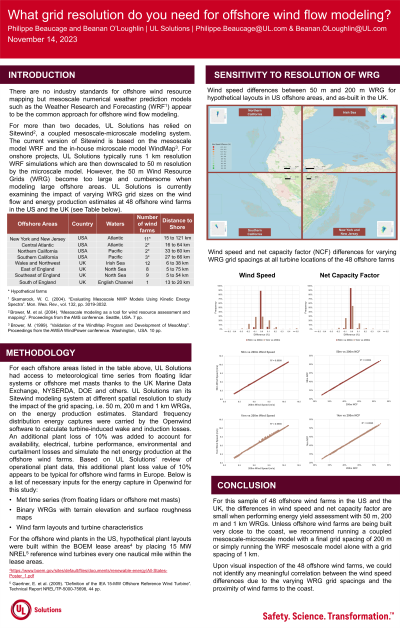Back

Wind: Offshore & Metocean
What grid resolution do you need for offshore wind flow modeling?
Tuesday, November 14, 2023
4:15pm – 5:15pm CST


Philippe Beaucage, PhD
Lead Research Scientist
UL Solutions
Brossard, Quebec, Canada
Presenter(s)
Presentation Description: Wind flow modeling approaches based on mesoscale numerical weather prediction (NWP) models such as the Weather Research and Forecasting (WRF) are likely the most common ones in the wind industry. UL and DTU independently pioneered a method to couple a mesoscale NWP model and a microscale model, i.e. the Sitewind system(Brower 1999) and KAMM/WAsP (Frank and Landbergh 1997), respectively. For more than two years/decades, UL has relied on the Sitewind modeling system (Brower 1999). UL has employed a 1 km mesoscale resolution coupled with a 50 m microscale resolution as standard practice for onshore wind resource assessment. While these mesoscale/microscale resolutions are appropriate for the spatial scale of most onshore wind farms, the size of the resulting wind resource grid becomes cumbersome when applied to the large areas of typical offshore wind projects. UL is currently examining the impact of varying grid size and mesoscale/microscale model combinations on wind flow and energy production estimates at 20+ offshore locations in the US and Europe. So far our analysis shows that there are no material differences in modeled wind speeds between running the microscale model at 50 m or 200 m grid spacing at several locations on the US East and West coasts. In addition, we’ve found that skipping the microscale model run and simply relying on the 1 km resolution WRF data provides similar mean wind speeds.
Learning Objectives:
- Review of different wind flow models used in the industry for offshore wind resource mapping
- Learn about the most efficient approach for offshore wind flow modeling with a mesoscale model or a combination of mesoscale and microscale model
- See regional differences in the accuracy of WRF in the US and Europe waters

